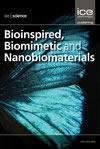新戊草滑带接触角的测量与模型分析
IF 0.6
4区 工程技术
Q4 ENGINEERING, BIOMEDICAL
引用次数: 0
摘要
阿拉塔猪笼草的滑带取决于其高度进化的形态和结构,以显示出显著的超疏水性,这已逐渐成为开发超疏水材料的仿生原型。然而,通过模型分析还没有完全揭示这种现象的机制。本文通过接触角测量、形貌/结构检测和模型分析,研究了滑带的超疏水性。光滑区域导致超纯水滴产生相当高的接触角(155.11–158.30°),并具有由月状细胞和蜡覆盖物组成的微纳米级分级结构。根据Cassie-Baxter方程和一个自定义的渗透系数,建立了一个模型来分析结构特性对接触角的影响。分析结果表明,计算的接触角(154.67–159.49°)与测量的接触角高度一致,表明所建立的模型能够定量表征接触角与结构特征之间的关系。我们的研究为进一步揭示有尾猪笼草滑带的超疏水机制提供了一些证据,并启发了超疏水表面的仿生发展。本文章由计算机程序翻译,如有差异,请以英文原文为准。
Contact Angle of Nepenthes alata Slippery Zone: Results from Measurement and Model Analysis
The slippery zone of Nepenthes alata depends on its highly evolved morphology and structure to show remarkable superhydrophobicity, which has gradually become a biomimetic prototype for developing superhydrophobic materials. However, the mechanism governing this phenomenon has not been fully revealed through model analysis. In this paper, the superhydrophobicity of slippery zone is studied by contact angle measurement, morphology/structure examination and model analysis. The slippery zone causes ultrapure water droplet to produce a considerably high contact angle (155.11–158.30°), and has a micro-nano scale hierarchical structures consisting of lunate cells and wax coverings. According to the Cassie-Baxter equation and a self-defined infiltration coefficient, a model was established to analyze the effect of structure characteristic on the contact angle. Analysis result showed that the calculated contact angle (154.67–159.49°) was highly consistent with the measured contact angle, indicating that the established model can quantitatively characterize the relationship between the contact angle and the structure characteristic. Our study provides some evidences to further reveal the superhydrophobic mechanism of Nepenthes alata slippery zone, as well as inspires the biomimetic development of superhydrophobic surfaces.
求助全文
通过发布文献求助,成功后即可免费获取论文全文。
去求助
来源期刊

Bioinspired Biomimetic and Nanobiomaterials
ENGINEERING, BIOMEDICAL-MATERIALS SCIENCE, BIOMATERIALS
CiteScore
2.20
自引率
0.00%
发文量
12
期刊介绍:
Bioinspired, biomimetic and nanobiomaterials are emerging as the most promising area of research within the area of biological materials science and engineering. The technological significance of this area is immense for applications as diverse as tissue engineering and drug delivery biosystems to biomimicked sensors and optical devices.
Bioinspired, Biomimetic and Nanobiomaterials provides a unique scholarly forum for discussion and reporting of structure sensitive functional properties of nature inspired materials.
 求助内容:
求助内容: 应助结果提醒方式:
应助结果提醒方式:


